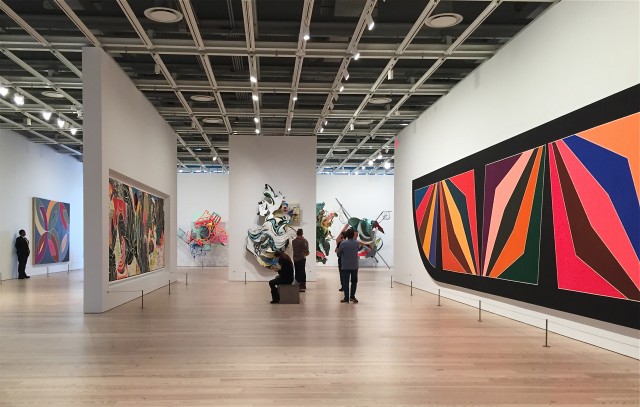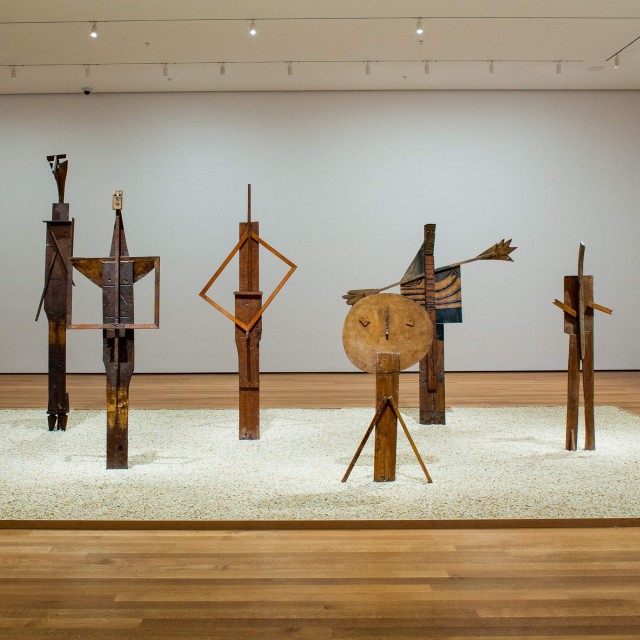
Wide range of Frank Stella’s paintings are on view at the Whitney through February 7 (© 2015 by Frank Stella / photo by twi-ny/mdr)
FRANK STELLA: A RETROSPECTIVE
Whitney Museum of American Art
99 Gansevoort St.
Through February 7, $18-$22
212-570-3600
whitney.org
This is the last weekend to see two major exhibitions, retrospectives of artists who bucked trends and did things their way, two seminal figures in the history of twentieth-century art, one of whom is still at it. “Frank Stella: A Retrospective” continues at the Whitney through February 7, while “Picasso Sculpture” ends the same day at MoMA. “In 1970, when Mr. Stella was thirty-four, the Modern celebrated his haloed progress with an eleven-year survey,” Roberta Smith pointed out in her October 29 article about the Stella show. “In 1987, when the sheen was fading, the museum devoted a second survey of the intervening seventeen years of work. He was beginning to seem like the Modern’s fledgling Picasso replacement.” So it is rather appropriate that the two shows are running concurrently. The Whitney closed its uptown location last October with a controversial Jeff Koons retrospective that had critics wetting their lips waiting to tear it apart. The Whitney has now followed its downtown inaugural “America Is Hard to See” show, which highlighted works from the museum’s collection, with a survey of another artist whom many critics have tired of. A Massachusetts native and longtime New Yorker, Stella has dedicated his six-decade career to abstract painting on multiple surfaces and using a wide range of colors, in an endless array of series. He was very involved in the Whitney retrospective, which is essentially chronological until it’s not. Approximately one hundred works are on view, from such series as “Black Paintings” (“Die Fahne hoch!”), “Irregular Polygons” (“Empress of India,” “Harran II”), “Exotic Birds” (“Eskimo Curlew”), and “Moby-Dick” (“Gobba, zoppa e collotorto”), as well as such one-offs as the massive forty-foot acrylic on canvas mural “Das Erdbeben in Chili [N#3].” Even as Stella’s work grew more sculptural and three-dimensional, with metal constructions that jut out from walls, he still considered them paintings. “Most people would call this a sculpture, but in many respects, this is still painting for Frank,” exhibition organizer and Whitney director Adam D. Weinberg says on the audio guide to “Raft of the Medusa (Part I).” “This is really about using three‑dimensional form for almost two‑dimensional purpose. He’s very interested in the surfaces, the light, and reflection, and the idea that these elements though then spring forward, and yet stay clinging to the raft of the grid.” Stella once famously said, “What you see is what you see.” If you look hard enough, you might even see the seventy-nine-year-old Stella himself, who has been known to drop by the exhibition to see how much people are enjoying it, even if the reviews have been decidedly mixed.

Six Cannes “Bathers” are among the many highlights of MoMA sculptural survey of Pablo Picasso (© 2015 the Museum of Modern Art / photo by Pablo Enriquez)
PICASSO SCULPTURE
Museum of Modern Art
Floor 4, Painting and Sculpture II Galleries
11 West 53rd St. between Fifth & Sixth Aves.
Through February 7, $14-$25
212-708-9400
www.moma.org
You’re not going to see Pablo Picasso at MoMA’s stunning survey of his sculptures, which has deservedly received rapturous reviews. But you are going to experience some 141 works arranged chronologically in 11 galleries, beginning in 1902 and concluding in 1964, set up like a lovely forest you can wander through at your own pace, filled with marvelous creatures, many of which have never been in the United States before and were rarely, if ever, displayed publicly during the artist’s lifetime. “An emphasis on the sculptures’ absence has eclipsed a rich body of evidence underscoring the vitality of their presence,” organizers Ann Temkin and Anne Umland write in the exhibition catalog. “One might say that Picasso’s sculpture stands apart from the paintings and works on paper in the remarkable efficiency with which it accomplished its many reinventions and redefinitions. But in its ongoing dance between the private and the public, the intimate and the monumental, the experimental and the definitive, the sculpture reveals itself as a quintessential rather than exceptional aspect of Picasso the artist.” Each gallery contains masterful treasures, from 1909’s “Head of a Woman” to 1913’s “Still Life with Guitar,” from 1929-30’s “Woman in the Garden” to 1943’s “Man with Lamb,” from 1951-52’s “Crane” to 1950-54’s “Woman with a Baby Carriage.” One of the most charming displays is the six-piece “Bathers” series, a half dozen abstract wooden figures made in Cannes in 1956 and arranged amid white rocks as if on the beach in the French Riviera. Picasso is one of those geniuses whose work lives up to all the hype, and this exhibit is no exception. Get your timed tickets now and don’t miss it.